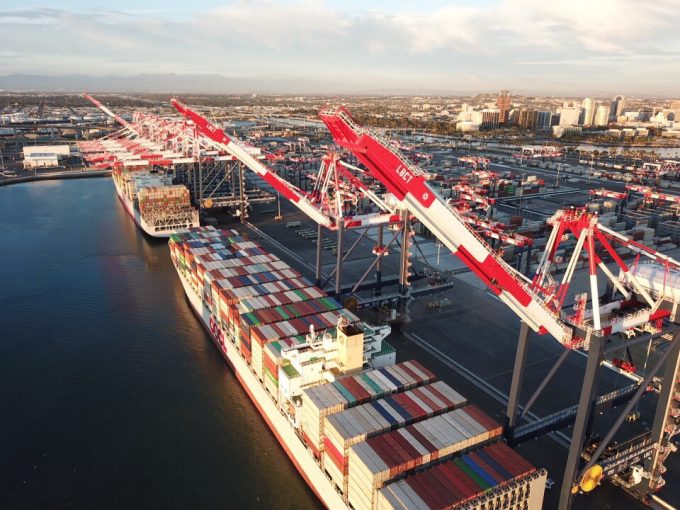Port privatisation off, but Santos STS10 terminal concession will be up for grabs
Brazil’s Ministry for Ports and Airports has decided to expand the container handling capacity of ...
GM: RAISING THE ROOF GGM: IN FULL THROTTLE GZIM: MAERSK BOOST KNIN: READ-ACROSSMAERSK: NOT ENOUGHMAERSK: GUIDANCE UPGRADEZIM: ROLLERCOASTERCAT: HEAVY DUTYMAERSK: CATCHING UP PG: DESTOCKING PATTERNSPG: HEALTH CHECKWTC: THE FALLGXO: DEFENSIVE FWRD: RALLYING ON TAKEOVER TALKODFL: STEADY YIELDVW: NEW MODEL NEEDEDWTC: TAKING PROFIT
GM: RAISING THE ROOF GGM: IN FULL THROTTLE GZIM: MAERSK BOOST KNIN: READ-ACROSSMAERSK: NOT ENOUGHMAERSK: GUIDANCE UPGRADEZIM: ROLLERCOASTERCAT: HEAVY DUTYMAERSK: CATCHING UP PG: DESTOCKING PATTERNSPG: HEALTH CHECKWTC: THE FALLGXO: DEFENSIVE FWRD: RALLYING ON TAKEOVER TALKODFL: STEADY YIELDVW: NEW MODEL NEEDEDWTC: TAKING PROFIT

Ahead of its acquisition by COSCO, ocean carrier OOCL’s carryings jumped 7.5% year on year, to 1.58m teu, in the first quarter, while revenue surged 16%, to $1.38bn.
According to the operational numbers at least, Hong Kong-based OOCL enjoyed a better and more profitable quarter than its suitor.
On the transpacific tradelane, its second-biggest trading region after intra-Asia/Australasia, OOCL achieved liftings growth of 16.3%, to 457,461 teu, with revenue improving by 19.2%, to $529m.
Asia-Europe trade leapt 20.5%, to 302,679 teu, with revenue 23.8% higher at $281m, and although intra-Asia/Australasia throughput declined 1%, to 716,390 teu, OOCL still managed to earn more, increasing revenue by 13% to $398m.
Overall average revenue per teu increased by 8.3% per teu, compared with Q1 2017.
Vessel utilisation was down 6.4%, but this was a “satisfactory achievement”, given that OOCL’s capacity increased by 16% as new ultra-large container vessels were delivered.
For the full- year 2017, OOCL carried 6.3m teu on its liner services, producing turnover of $5.4bn.
Its parent company, OOIL, posted a full-year net profit of $138m – reversing a loss of $219m incurred the previous year.
Meanwhile, China state-owned COSCO saw profits slump by a third, year-on-year, in the first quarter, to $28.4m, despite an increase in liftings, as it focused on growing market share.
It loaded 5.2m teu on its vessels in the first three months, representing a near 12% jump on the previous year and significantly ahead of par for the market.
The Shanghai-listed carrier also returned to the black last year, posting a net profit of $264m after a loss of $1.1bn in 2016.
Assuming the $6.3bn purchase of OOIL is completed, COSCO will hold 90.1% of the shares, while compatriot container terminal operator Shanghai International Port Group (SIPG) will acquire the balance of the stock.
According to the terms of transaction the deal must be completed by 30 June or OOIL could be entitled to a break fee of around $250m, and it appears the deal could potentially be blocked at the eleventh hour by US national security issues.
According to a transaction update last month from COSCO’s vice-chairman, Huang Xiaowen, the company was still answering questions from the Committee on Foreign Investment in the US (CFIUS) relating to assets OOCL owns in America.
In the past year, CFIUS has vetoed a number of deals involving Chinese buyers on the basis of a “threat to national security”. In this case, the sticking point seems to be OOCL’s Pier E/Pier F Long Beach Container Terminal.
This would pass into Chinese ownership, adding to the group’s controlling interests at two other container terminals in the Los Angeles-Long Beach San Pedro Bay port complex.
According to Alphaliner, to appease the concerns of CFIUS, COSCO might be prepared to spin-off its LA/LB terminal concessions “in order not to risk or delay the overall merger with OOCL”.
Elsewhere, Hapag-Lloyd is scheduled to publish its Q1 results on 14 May and market leader Maersk on 17 May. The normal transparency and outlooks provided by the German and Danish carriers will give an insight to current and future trading conditions in liner shipping.
Of concern to ocean carriers is softening container spot rates in Q1, while fuel costs and vessel chartering expenses have escalated.
Comment on this article